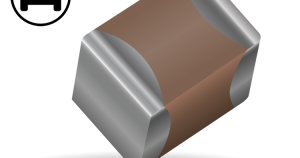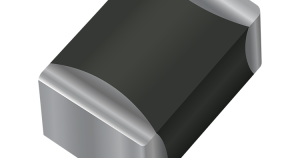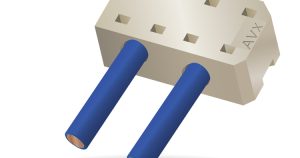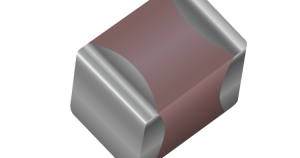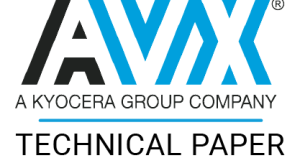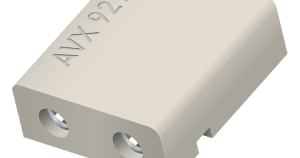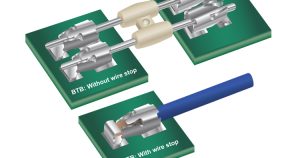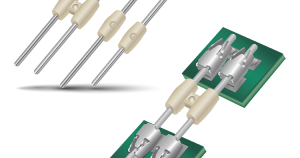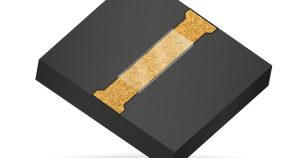Capacitor Pi Network for Impedance Matching Application Note 026 Abstract: Designing matching networks is one of the key aspects of RF/Microwave design. A lossless network that matches an arbitrary load to real impedance has to have at least two reactive elements. However, two elements do not give control over the bandwidth and the degree of match simultaneously. Three-element matching networks, i.e. Pi- and Teenetworks, provide additional control of the frequency response.
Technical Articles / Whitepapers
RF Ceramic Chip Capacitors in High RF Power Applications Abstract: In today’s world of wireless communications systems there are a myriad of high RF power applications that necessitate the use of high quality specialized ceramic chip capacitors. These demands require the designer to carefully account for factors such as device power dissipation and maximum current and voltage ratings as well as thermal resistance and temperature rise during normal circuit operation. This article highlights some of the most essential elements needed for selecting capacitor products suitable for these applications.
The Case for Ceramic Capacitors in Electric Vehicle DC-DC Converters Written By: John Lee | Simon Cen Abstract: The emergence and future ubiquity of electric vehicles have created one of the most demanding application spaces for capacitors across a wide variety of use cases. From AC charging circuits to high-speed analog sensors, electric vehicles span the gamut of design constraints while also requiring the highest reliability standards in the worst possible environments.
KYOCERA AVX Varistors for Automotive Ethernet Written By: Akihiro Kado | Michael Kirk Abstract: The ubiquity of high-performance sensor systems in modern automobiles (particularly electric and self-driving vehicles) has created immense pressure to develop automotive local area networking (LAN) solutions that offer high bandwidth, low latency, and low cost. Traditional wiring harnesses have become too heavy and complex to support these data and power needs.
Criteria for Selecting Connectors for LED Lighting/Industrial Applications Written By: Jeffery Wang | John Lee Abstract: Connectors used in industrial and solid-state lighting applications pose uniquely challenging design constraints on power density and form-factor while simultaneously demanding the highest reliability under harsh environmental conditions. As a designer in these spaces, one cannot simply prioritize piece cost in the connector selection process. The true value of a connector is much more nuanced and must include the amortized costs of manufacturability, reliability, and safety. Eliminating hand soldering, ease of use, and good yield are not free. Avoiding field failures and product recalls are not free. Regulatory compliance is not free. To best address these hidden costs, designers should choose connectors from suppliers
Conductive Epoxy Attachment of Capacitors Written By: Ron Demcko | Ashley Stanziola Abstract: Compared to the vast majority, capacitor attachment via conductive epoxy is not a common technique among end-user applications. A significant amount of growth in capacitor usage has occurred in solder attachment methods. Furthermore, many publications on attachment methods focus predominantly on optimizing the multiple methods of solder component attachment. Therefore, confusion exists on the requirements needed to ensure reliable long-term attachment when using conductive epoxy material systems. This paper serves as a general introduction to conductive adhesives. It aims to assist end-users in the conductive epoxy attachment of SMT (Surface Mount Technology) components.
Passive Automotive Electronics for 48V Systems and V2X Written By: James Emerick Abstract: Two of the driving forces behind the quickly evolving automotive industry are fuel efficiency and safety. Fuel efficiency is primarily driven by a combination of regulatory requirements for reduced CO2 emissions and consumer demands for improved operational economy. While always paramount, safety has seen renewed activity due to the advancements of driver-assist and driverless technologies. The shift toward 48V subsystems and the integration of vehicle-to-everything (V2X) communication are two prime examples of significant advances in efficiency and safety, respectively. In both cases, new classes of electronic passives (capacitors, inductors, antennas, interconnect) are required to bring these technologies to mainstream products while meeting strict automotive regulatory standards.
LED Lighting Interconnects Solutions Written By: Alex Guan Abstract: Solid-state lighting (SSL) solutions based on the light-emitting diode (LED) and its organic relative (OLED) have become the standard for luminaires across a wide variety of application sectors. SSL performance with respect to luminous output, power efficiency, lifetime, and reliability is unmatched. Many of the challenges endured by early adopters, such as cooling, manufacturability, and form factor limitations, have largely been solved. By the year 2035, it is projected that 85% of all lighting installations will be solid-state (“2019 Lighting R&D Opportunities”).
Active Band Switching Solutions Written By: Alessandro Beretta Abstract: Today’s new and emerging wireless applications are increasingly requiring the support of multiple frequency bands. From laptops to cellular phones to wearables, devices are expected to connect to any cellular, Bluetooth™, GSM, RFID, or other networks. These expectations present challenges when it comes to antenna design, compared to a traditional design. The simplest solution — using discrete antennas for each frequency band required in the application — requires extra physical space. But this ultimately clashes with industry trends that prefer smaller and smaller solutions while still providing more bandwidth.
Five Advantages of AVX Poke-Home Connectors Written By: Raul Saucedo Abstract: The poke-home connector was originally introduced as a highly reliable solution for connecting a small number of discrete wires to a printed circuit board assembly. The wire is first stripped, and it is then inserted into the connector. Integral wire guides and an end stop assure proper positioning of the wire during insertion. Dual beam high force contacts (typically beryllium copper) provide extremely low electrical resistance and maximize wire retention. An example of a horizontal poke-home connector is shown in…
Leading-Edge AVX Technology in Film Capacitors Written By: Masato Nishikiori Abstract: With the advent of plastics in the middle of the 20th century, the film capacitor was introduced as a technological leap over traditional paper-based designs. Film capacitors use a thin plastic film as the dielectric that separates multiple metal electrodes. The electrodes are either deposited directly on the film (metallization) or are built from separate metal foils. The plastic metal sandwich is wound on a bobbin, and a terminal contact layer is deposited to connect all of the individual capacitor layers in parallel effectively.
AVX Jumper Pins: Solutions for Solid-State Lighting Board-to-Board Applications Written By: Raul Saucedo Abstract: It is now a foregone conclusion that solid-state lighting (SSL), specifically based on the light-emitting diode (LED) and it’s organic relative (OLED), will become the technology standard for luminaires across a wide variety of application sectors. Its performance with respect to luminous output, power efficiency, lifetime, and reliability is unmatched. Many of the challenges endured by early adopters, such as cooling, manufacturability, and form factor limitations, have largely been solved. By the year 2035, it is projected that 85% of all lighting installations will be solid-state (“2019 Lighting R&D Opportunities”).
Passive Components for GaN Based Devices Written By: Ron Demcko | Daniel West Abstract: The theoretical limits of Silicon-based device performance are fast approaching, and in some cases, already here. Therefore, IC (integrated circuit) design companies have turned their efforts into driving costs down while increasing the performance of wide band gap semiconductors such as GaN (Gallium Nitride). GaN based power and RF (Radio Frequency) devices are now available from multiple manufacturers at affordable prices due to those intensive efforts. Multiple sources have documented GaN based semiconductor performance advantages of faster speed, lower loss, and higher frequency-voltage-temperature operation. Those advantages are, in turn, enabling end systems that have enhanced performance on lower power consumption levels in smaller and lighter packages,
The History of Insulation Displacement Technology Written By: Hank Merkle Abstract: The need to physically connect pieces of metal together has been around for thousands of years. In the modern era of electronics, the physical connection requirement is compounded by the need for a low resistance electrical path. In both cases, the process of soldering has proven to be an excellent and time tested solution, with evidence dating back to 4,000 BC. Soldering two metal components together means that the joint is heated and a filler metal with a lower melting point than the constituent pieces is deposited to complete the connection.
The Pros and Cons of MLCC Downsizing Written By: Frank Hodgkinson | Maureen Strawhorne Abstract: As integrated circuits (ICs) continue to pack more functionality into smaller packages, the need for bulk off-chip capacitance remains. In resonant circuits, such as phase-lock-loops (PLLs) and switching regulators, precision class one ceramic capacitor may be required. Such capacitors must maintain a tight capacitance range over process, voltage, and temperature variation (PVT) for the host IC to meet its performance specifications. In contrast, class two ceramic capacitors are required for nearly every IC in the form of decoupling and bypass capacitance. They may also be found in amplifier circuits, simple filters, and linear regulators where their function is less dependent on tightly specified impedance requirements.
The Application of Capacitors in Power Supply Regulator Circuits Written By: Rick Liu Abstract: Advancements in electronic technology over the last decade have led to smarter consumer electronics. As devices become smarter, the components used to power them are shrinking, resulting in small, but incredibly powerful devices — ones small enough to fit inside a pocket or around a wrist. With these smaller, denser designs, it can be impossible to separate analog and digital domains in the layout, as best practices used to dictate years ago. Today, design engineers are compelled to use many capacitors in the power network to attenuate high-frequency digital noise. Circuits are designed to expect pure, clean power without noise that will impact analog circuits.

